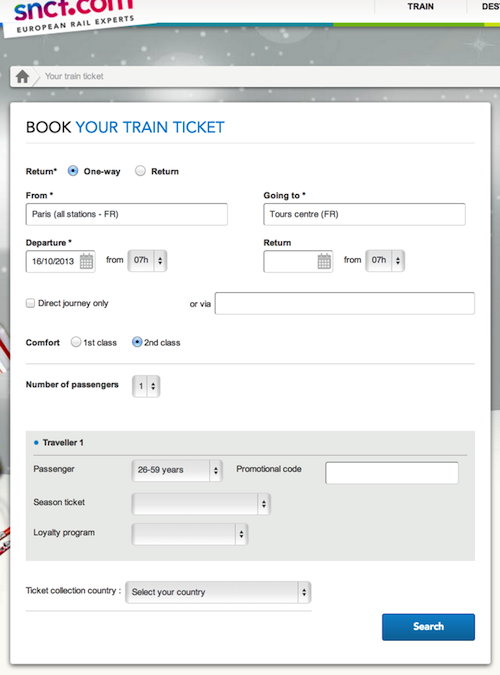Buying a TGV train ticket, making a reservation for your pet dog: Confusing differences between French and English SNCF Voyages sites
I’m posting this because we ran into a vexing discrepancy between the French and English versions of the SNCF Voyages pages: We could not add Chloe to our TGV reservation on the English site, but we could have on the French site. Save yourself an extra step and book your travel on the French site.
A quick overview to get you oriented: SNCF operates France’s national train system; and a piece of it, SNCF Voyages, operates the high-speed, long-distance TGV (“train à grande vitesse”) network covering France and reaching into Belgium, Luxembourg, and Switzerland (under the name TGV Lyria). Pet dogs can travel on TGV trains — small dogs in carriers like Chloe cost only 6 €, while large dogs (leashed and muzzled) cost half the fare of a full-price Second Class ticket.
My husband and I went on-line, opting to use the English SNCF Voyages site, and bought our tickets for a day trip to Tours. As you can see, we were not offered the option to add Chloe to our reservation — and that wasn’t a surprise, since the directions told us that “pet tickets are not available at [the English site]” but can instead be purchased at an SNCF station or shop.
Checking on details of our seating, however, we ended up on the French site, which does offer you the option of adding your pet to your reservation. In a further twist, that option is not presented to you if you start filling in the “Réservez un billet de train” box that’s waiting for you on SNCF Voyages’ home page:

The first opportunity you’re given to reserved tickets does not make it easy to add your pet to your reservation — ignore the opening screen on the French SNCF Voyages site.
What you have to do instead is ignore that box and click on the “Train” icon in the menu, and then, under the category “Réserver,” click on “Réserver un billet”:
When you do that, you’re given a form that, as soon as you tell it where you want to depart from, gives you the opportunity to click on the link “Voyagez avec votre animal de compagnie.”
That leads you, via another link (click on “En savoir plus”), to a page packed with further links and information about pet travel — none of which is available on the English site. It also lets you specify how many pets you’re traveling with (2 is the maximum), and request a reservation.
It’s not the end of the world that we missed this option — we arrived a little earlier at the Gare Montparnasse, located the billeterie for the “Grandes Lignes,” and stood in line to talk to a ticket agent — but it did add an unnecessary layer of complication to our plans (two layers, in fact, since we tried to visit an SNCF boutique the day before our trip, and learned they were all closed because of a “mouvement social national”). In the future, we’ll start with the SNCF’s French site, and I suggest that you do too.







